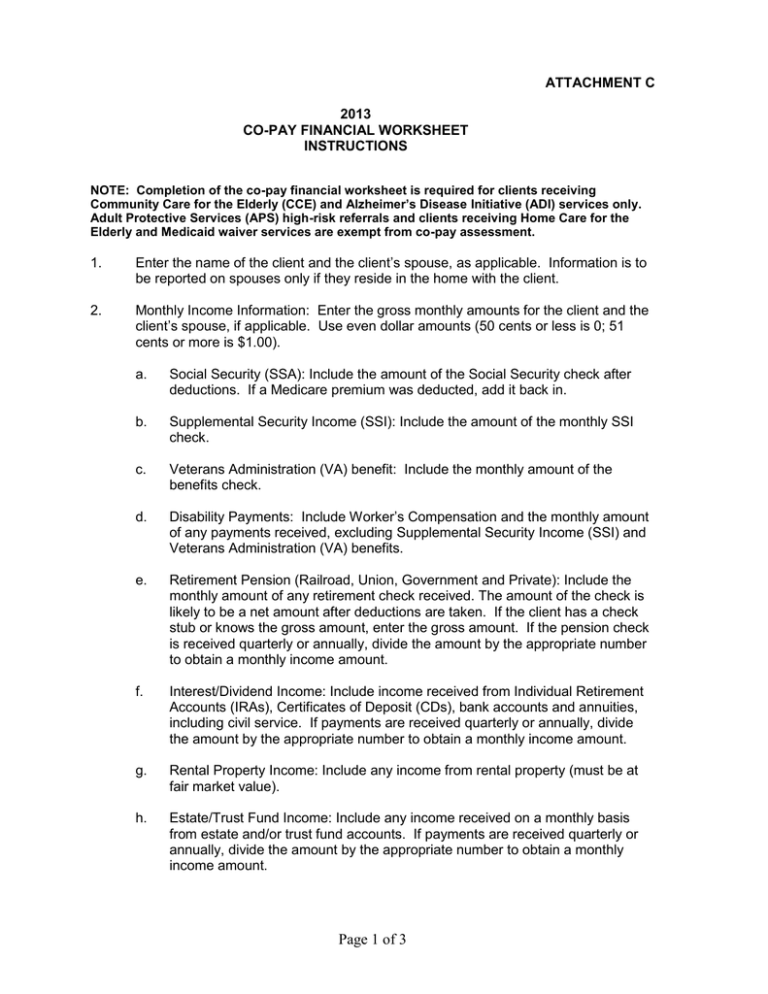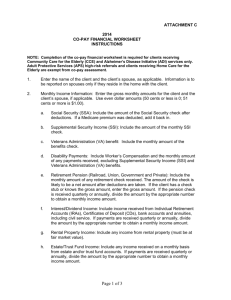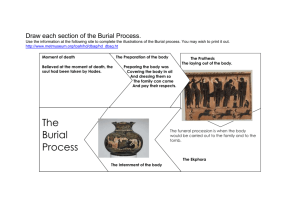Attachment C
advertisement

ATTACHMENT C 2013 CO-PAY FINANCIAL WORKSHEET INSTRUCTIONS NOTE: Completion of the co-pay financial worksheet is required for clients receiving Community Care for the Elderly (CCE) and Alzheimer’s Disease Initiative (ADI) services only. Adult Protective Services (APS) high-risk referrals and clients receiving Home Care for the Elderly and Medicaid waiver services are exempt from co-pay assessment. 1. Enter the name of the client and the client’s spouse, as applicable. Information is to be reported on spouses only if they reside in the home with the client. 2. Monthly Income Information: Enter the gross monthly amounts for the client and the client’s spouse, if applicable. Use even dollar amounts (50 cents or less is 0; 51 cents or more is $1.00). a. Social Security (SSA): Include the amount of the Social Security check after deductions. If a Medicare premium was deducted, add it back in. b. Supplemental Security Income (SSI): Include the amount of the monthly SSI check. c. Veterans Administration (VA) benefit: Include the monthly amount of the benefits check. d. Disability Payments: Include Worker’s Compensation and the monthly amount of any payments received, excluding Supplemental Security Income (SSI) and Veterans Administration (VA) benefits. e. Retirement Pension (Railroad, Union, Government and Private): Include the monthly amount of any retirement check received. The amount of the check is likely to be a net amount after deductions are taken. If the client has a check stub or knows the gross amount, enter the gross amount. If the pension check is received quarterly or annually, divide the amount by the appropriate number to obtain a monthly income amount. f. Interest/Dividend Income: Include income received from Individual Retirement Accounts (IRAs), Certificates of Deposit (CDs), bank accounts and annuities, including civil service. If payments are received quarterly or annually, divide the amount by the appropriate number to obtain a monthly income amount. g. Rental Property Income: Include any income from rental property (must be at fair market value). h. Estate/Trust Fund Income: Include any income received on a monthly basis from estate and/or trust fund accounts. If payments are received quarterly or annually, divide the amount by the appropriate number to obtain a monthly income amount. Page 1 of 3 i. Alimony: Include any income received monthly from court ordered alimony support payment. j. Regular Contributions From Another Person: Include any income received on a regular basis (monthly, quarterly, annually). Do not include any gift income, regardless of frequency or amount. Gift income is defined as income from a person, family, or friend not legally obligated to provide such to the client. Payment of bills (e.g., phone, electric, gas) by someone on the client’s behalf is not considered a regular contribution. k. Temporary Assistance for Needy Families (TANF): Include amount of assistance. l. Other Income: Include other regularly received income not included in any of the above categories. For example, if the spouse is employed, enter the gross monthly amount earned as "other income." Total Gross Monthly Income: Total each entry to arrive at the figure. 3. Refer to the co-pay chart (Attachment A) to find the income range for individual client or couple and enter the co-pay amount for the client’s income range on line 3. 4. Asset Information: a. Include the declared value of the client's additional car(s), only if the car is less than seven years old or over 25 years old. One car is excluded no matter the age or type. A couple, if both are receiving services, may own two cars. b. If the total face value of life insurance policies exceeds $2,500.00, count the cash value of the policies as an asset. These policies may be designated as burial funds. c. Include the balance of the client's checking account(s) on the day of the application. If the client jointly holds an account with another person (__"and"__), the funds and any interest received are equally divided. If the client has unrestricted access to the funds (__"or"__), the entire balance and all interest received are considered the client's. d. Include the balance of the client's savings account(s) on the day of the application. If the client jointly holds an account with another person (__"and"__), the funds and any interest received are equally divided. If the potential client has unrestricted access to the funds (__"or"__), the entire balance and all interest received are considered the client's. e. The cash that is “on hand” should be included. Cash from a regular source of income that has already been included on the financial worksheet (i.e., money from a cashed Social Security check) should not be included. f. Include the cash surrender value of Certificates of Deposit (CDs), minus any penalties for early withdrawal. Certificates of Deposit (CDs) can also be designated as burial funds. Page 2 of 3 g. Include the cash surrender value of Individual Retirement Accounts (IRAs), minus any penalties for early withdrawal. Individual Retirement Accounts (IRAs) cannot be designated as burial funds. h. Include the cash value of a revocable burial contract. i. Include the total balance of a trust account if the trust was set up by the client for his/her benefit, or if the spouse set up a trust for the client, regardless of availability. Trust money or property held by a trustee for the benefit of an individual who is the beneficiary should not be included. The principal balance of such trusts is not usually available to the beneficiary; thus, it is not considered an asset. j. Include the value of any stocks, bonds, and mutual fund shares owned by the client. The value of stocks is determined by the closing price as of the date of application. This information can be found in newspapers and on the Internet. The value of bonds and mutual fund shares can be verified through a stockbroker. Verification of the value of United States (US) Savings Bonds can be obtained from a bank. k. Include the value of real property owned in Florida or elsewhere. This includes land and other associated buildings on land in which the client has an ownership interest, such as mineral rights, timber rights, leasehold, or an allotment to farm on a particular piece of land. If ownership is shared, the value is divided equally among the owners. If rental income of a fair market value is received, the property is not counted as an asset. Enter the total/subtotal assets. Clients may designate up to $2,500 (individual) or $5,000 (couple) as burial funds to help bring their assets within limit. 5. Have client or responsible party sign and date form after reading the affirmation statement. Complete information as indicated for person preparing the worksheet. Page 3 of 3


